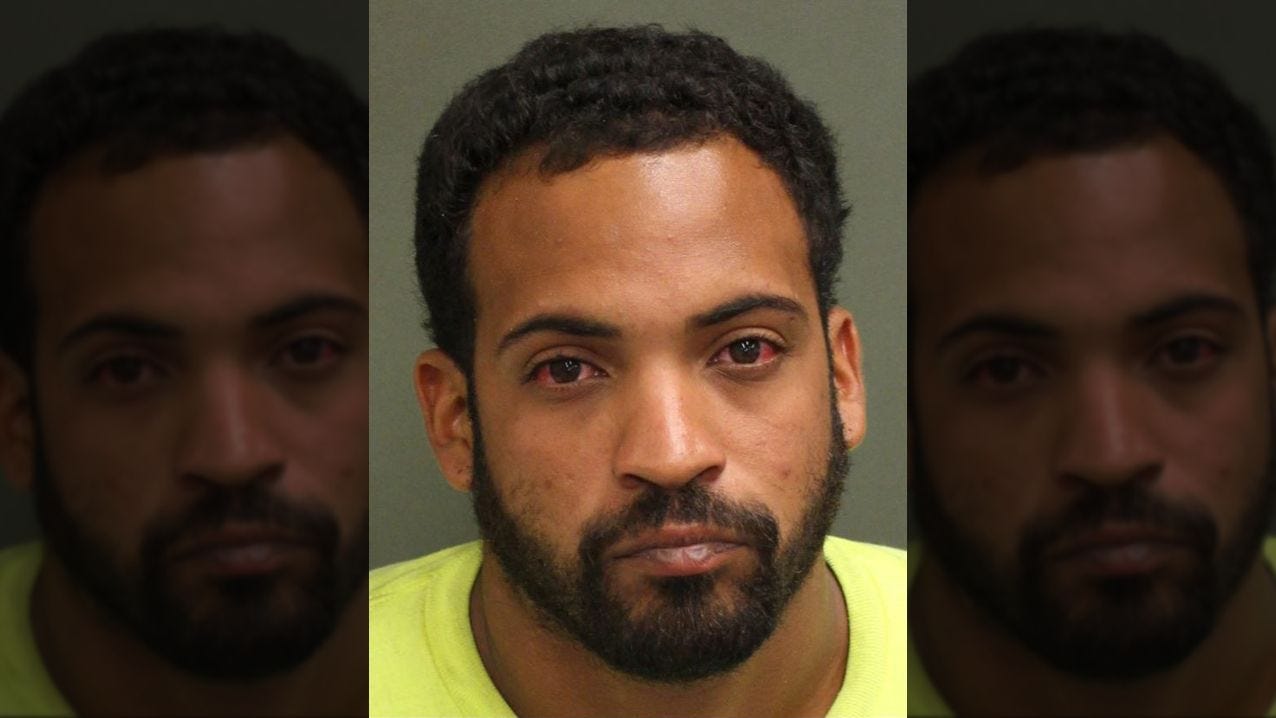This week, four alleged or convicted serial killers were in the news, all at different stages of the legal process. Here's a summary of what happened, what our information suggests about their motives and makeup, and the investigative techniques used to stop them.
Alleged Serial Killer Apprehended in Mexico City
Mexican authorities have arrested a 39-year-old pharmaceutical chemist named Miguel Cortez, who they believe is responsible for the murders of multiple women in Mexico City. The victim that led to his arrest was seventeen-year-old María José Calles. On April 16th, 2024, Cortez, who resided in the same apartment building as the victim and her mother, allegedly sexually assaulted María before stabbing her to death in her bedroom.
Miguel Cortez, accused serial killer
The victim's mother, Cassandra Calles, unexpectedly returned home from a trip to a corner store and found Cortez standing over her daughter. Attempting to defend her, she was viciously stabbed before the attacker fled. Miraculously, Cassandra survived and was able to identify Miguel, leading to his swift arrest.
Police were stunned when they searched Miguel N.'s apartment. They found a trove of grim evidence - human skulls, IDs of missing women, and disturbingly, notebooks detailing his crimes against female victims. Mexican media immediately tagged him as "the Mexican Jeffrey Dahmer." Authorities are now using DNA analysis to identify the remains and determine just how many women Miguel targeted.
As a forensic psychologist, several things stand out to me about this offender:
How similar his actions are to sexually motivated serial killers in the United States. He kept trophies and journals, showing a need to relive his crimes and suggesting the attacks were sexually motivated. Taking IDs demonstrates a desire to degrade and dehumanize victims.
Living in the same building provided access to victims and made him feel invulnerable and overconfident, leading to sloppiness in leaving a witness.
The brutal violence of the stabbing indicates rage and potentially a history of violence against women. I suspect more victims will be uncovered as the investigation unfolds.
This case is a tragic reminder of the crisis of femicide in Mexico, where authorities are often accused of minimizing and ignoring crimes against women. Hopefully, the evidence in this case is so overwhelming that the usual pattern of denial and victim-blaming won't occur here. But it is devastating that it took the horrific murder of María for this predator to finally be caught after likely years of attacks.
Winnipeg Serial Killer Suspect Fit to Stand Trial
In Winnipeg, the trial of alleged serial killer Jeremy Skibicki will proceed with a jury, after a judge rejected a second defense motion to have the jury tossed. Skibicki, 35, is charged with first-degree murder in the deaths of four indigenous women - Rebecca Contois, Morgan Harris, Marcedes Myran, and an unidentified woman named Mashkode Bizhiki'ikwe (Buffalo Woman) by elders.
Jeremy Skibicki
The defense has argued that extensive media coverage of the case has tainted the jury pool and will deprive Skibicki of a fair trial. They even commissioned an opinion poll showing a majority of respondents believe the defendant is guilty.
However, the judge ruled that carefully instructing jurors on their duty to be impartial and decide the case solely on the evidence presented in court would be sufficient to ensure a fair trial. He expressed faith that jurors can set aside biases and preconceived notions to focus objectively on the facts.
From a forensic psychology perspective, research does show pretrial publicity can sway jurors and make them more conviction-prone. The defense was right to raise this issue. That said, the judge's decision seems appropriate given the high-profile nature of the case - with a crime this serious, involving the murders of four indigenous women, the community likely wants to be involved in the process of justice through a jury of peers.
It will be crucial for the judge to deliver clear, firm instructions to jurors to put media reports out of their minds. Extensive, thorough questioning of potential jurors during the selection process will also be important to screen out those with fixed biases.
The other major issue to watch will be Skibicki's mental state and the defense's plan to argue he is not criminally responsible by reason of mental disorder. I'll be very curious to see what specific diagnosis they are claiming and what evidence they present regarding his mental condition at the time of the alleged murders. The bar to prove Not Criminally Responsible (NCR) is quite high in Canada; similar to the U.S., less than one percent of criminal defendants plead NCR and only about a quarter of those are successful.
No matter the ultimate verdict, this trial is an important chance for the families of the victims to learn the full truth about what happened to their loved ones and to see the judicial process play out. But it will no doubt be a long and emotionally agonizing case for all involved.
Pennsylvania Nurse Gets 760 Years for Murdering Patients
In a disturbing case out of Pennsylvania, a nurse who killed at least three patients and assaulted numerous others by injecting them with insulin has been sentenced to 760 years in prison.
Heather Pressdee, convicted serial killer
Heather Pressdee, 41, pleaded guilty to avoid the death penalty for three counts of murder and an astounding 19 counts of attempted murder. Her killing spree spanned at least 22 medical facilities, where she would deliberately inject patients with unnecessary and massive doses of insulin, intentionally causing fatal hypoglycemia.
This is a case of a healthcare serial killer, a category that includes some of the most prolific murderers in history, like Charles Cullen who may have killed up to 400 patients, and Donald Harvey who claimed 87 victims. There are several common motives of healthcare workers who kill:
A need for control and to feel like a powerful life-or-death agent
Munchausen syndrome by proxy, where they make patients sick to get attention/praise for "saving" them
Lack of empathy for vulnerable victims they view as subhuman
Access to drugs/methods to kill with plausible deniability if questioned
In Pressdee's case, her choice of insulin and the scale of her attacks suggest a kind of "angel of death" syndrome combined with sadistic enjoyment of a method that would make deaths look natural. It appears she went undetected for a long period of time, which speaks to major systemic failures in catching medical murders.
Her 760-year sentence reflects the sheer scale of her crimes and the outrage of the judge at her violation of trust. Though symbolic since she'll never serve it all, it sends an important message about the seriousness of what she did. The families may find some closure, but I'm sure many will be haunted wondering if prompt action could have saved lives.
Possible Serial Killer Caught in Orlando
Finally, in Florida, police have arrested a man they are calling a "potential serial killer" after linking him to the murders of two women whose bodies were dumped, one month apart, at the same Orlando intersection.
Carlos Yadiel Baez-Nieves, 25, allegedly confessed to strangling Fatia Flowers, 41, and Nichole Daniels, 44, after having sex with the women, both of whom were sex workers, and meeting them for liaisons in his white pickup truck. After killing the victims, he callously pushed their nude bodies out of his vehicle.
Carlos Yadiel Baez-Nieves, suspected serial killer
Investigators were able to connect the two cases after observing eerie similarities between the crime scenes. They then located surveillance video of Daniels getting into Baez-Nieves' truck the night she died. An attempt by the suspect to quickly sell his vehicle also raised red flags.
This appears to be a case of a sexually motivated serial killer who specifically targeted sex workers, a population vulnerable to predators who assume they won't be missed or that police won't investigate their deaths as vigorously. The link between sex work and victimization by serial killers is well-established, with Gary Ridgway, the Green River Killer, being one of the most notorious examples.
The quick thinking and coordination of the Orlando investigators may have prevented this offender from killing many more. Their ability to overcome the "linkage blindness" that often delays connecting the dots between serial crimes was key.
By seeing the pattern and moving quickly to get legal justification for DNA samples, they built a solid case. The video evidence and confession will also make this a strong case for prosecutors.
The tragedy is that it took the murders of two women for this predator to be caught. One can only hope that the victims’ families feel that justice is served and find some peace knowing Baez-Nieves is off the streets.
The Bottom Line
The cases from the last week take us from Canada to Mexico, clearly showing us that serial killers continue to operate across borders and jurisdictions. Dedicated investigators using tools like DNA and surveillance video, are working hard to stop them. But these predators are not dumb - they are deliberate, strategic, and ruthless in exploiting vulnerabilities in the system and in their choice of victims who are often marginalized. Law enforcement must be equally committed to collaboration, information sharing, and proactive policing approaches to identify patterns and catch offenders quickly.
It also requires that we as a society address the systemic and cultural attitudes that enable predators - the devaluing of indigenous women, the failures of medical oversight, the stigmatizing of sex workers, and the dismissal of crimes against women broadly. Only by tackling these big-picture issues can we prevent the proliferation of serial killers and ensure that "justice for all" truly means all victims. We'll keep monitoring developing cases and analyzing the latest techniques for understanding and catching these criminals.
Thank you for reading the Sunday edition of The Mind Detective. As always, please share with your crime-following friends. And, if you have a case you’d like us to cover, we’d like to hear about it.








It's interesting that resources such as the Radford University Serial Killer Database show a drop in the estimated number of active serial killers since the 1970s/80s, and yet here are four recent and appalling cases. Your point about society combating prejudice against indigenous people and sex workers is a strong one – let's hope law enforcement have taken those lessons on board to expedite the capture of killers like those listed in this post.